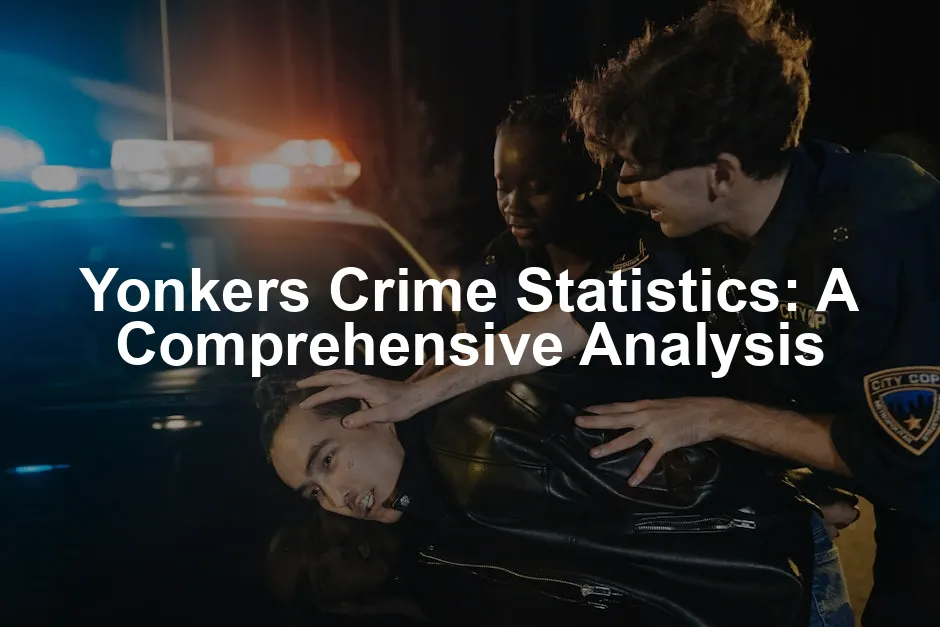Introduction
Understanding crime statistics in Yonkers, NY, is crucial for several groups. For residents, it shapes their daily lives. Potential movers weigh safety heavily in their decision-making. Researchers seek insights into urban dynamics and societal impacts. If you’re looking to dive deep into the psychological aspects behind criminal behavior, you might find The Psychology of Criminal Conduct by the experts can provide some fascinating insights into why crime happens in the first place! Data sources for crime statistics include local law enforcement agencies, the FBI, and various analytical platforms. These organizations provide valuable information about crime trends and rates. Knowing the crime landscape can help individuals make informed decisions about safety and community engagement. Societal implications of crime rates are profound. High crime rates can lead to fear and anxiety among residents, while low rates foster a sense of security and community pride. This article aims to break down Yonkers’ crime statistics, offering a detailed analysis. Speaking of societal implications, if you’re interested in the broader context of crime and its effects on society, The Oxford Handbook of Crime and Criminal Justice is a must-read! We will examine historical trends, current rates, and the types of crimes affecting residents. By providing this comprehensive overview, we hope to clarify the safety dynamics in Yonkers. Let’s dive into the numbers and uncover what they reveal about life in this vibrant city.
Overview of Yonkers Crime Statistics
Historical Context
Yonkers has witnessed notable shifts in crime rates over the years. Historically, crime rates surged in the early 2000s. However, recent years show a positive trend. The overall crime rate in Yonkers rose by 4% compared to 2021. Despite this increase, the current rates remain significantly lower than the national average. For those who love literature that delves into crime and punishment, consider picking up a copy of Crime and Punishment by Fyodor Dostoevsky. It’s a classic that explores the mind of a criminal. In the past decade, Yonkers experienced a gradual decline in violent crime. For instance, the murder rate dropped from over 8 incidents in 2000 to just 2 in 2022. This improvement reflects ongoing community efforts and law enforcement strategies to enhance public safety. However, property crime remains a concern. While the city has made strides in reducing violent crime, property crime rates have fluctuated. The challenge persists, indicating that more work is needed to ensure safety for all residents. If you’re curious about the historical perspective of crime, A History of Crime in England is a fascinating read!
Current Crime Rates
As of the latest reports, Yonkers’ crime statistics paint a mixed picture. The overall crime rate stands at 12.94 per 1,000 residents. This figure indicates that while safety measures have been effective, challenges remain. If you’re looking for a gripping story that involves crime, you can’t go wrong with the classic The Godfather—it’s a tale of power and crime that’s hard to resist! Breaking it down further, the violent crime rate is currently 3.25 per 1,000 residents. This includes serious offenses such as murder, assault, and robbery. In contrast, the property crime rate is notably higher at 9.69 per 1,000 residents. These numbers reveal that the likelihood of becoming a victim of violent crime in Yonkers is approximately 1 in 307. For property crime, the odds increase to 1 in 103. These statistics highlight the importance of community vigilance and the role of local law enforcement in enhancing safety. If you enjoy thrilling narratives that explore crime and its consequences, The Devil in the White City is a perfect fit! In the grand scheme, Yonkers’ crime rates are higher than 73% of cities in New York State. This comparison emphasizes the need for continued focus on crime prevention and community safety initiatives. Understanding these statistics is essential for residents and policymakers alike. They provide a foundation for informed discussions about safety and community improvements.For more insights into safety dynamics, check out the detailed analysis of yonkers crime statistics.

Breakdown of Crime Types
Violent Crimes
Violent crimes are serious offenses that involve force or threat of force. They include murder, rape, robbery, and assault. Each category has its own unique statistics, reflecting the safety concerns within Yonkers.- Murder: Yonkers reported 2 murders last year, giving it a rate of 0.01 per 1,000 residents. While this number seems low, any murder is a tragedy for the community.
- Rape: The city recorded 23 incidents of rape, resulting in a rate of 0.11 per 1,000 residents. This statistic indicates a pressing issue that requires attention and community support.
- Robbery: Robbery is more common in Yonkers, with 208 incidents reported. This translates to a rate of 1.00 per 1,000 residents. It’s essential to remain vigilant, as these crimes can happen anywhere.
- Assault: Assault cases are quite prevalent, totaling 444 incidents or a rate of 2.13 per 1,000 residents. This high number suggests ongoing challenges in maintaining public safety.

Property Crimes
Property crimes involve the theft or destruction of someone else’s property. These crimes include burglary, theft, and motor vehicle theft, which are prevalent in Yonkers.- Burglary: There were 242 reported burglaries, leading to a burglary rate of 1.16 per 1,000 residents. This statistic reveals that homes and businesses are at risk, requiring residents to enhance their security measures.
- Theft: Theft reigns supreme in Yonkers, with a staggering 1,513 incidents, resulting in a rate of 7.27 per 1,000 residents. This high number underscores the importance of community awareness and crime prevention strategies.
- Motor Vehicle Theft: There were 261 incidents of motor vehicle theft, equating to a rate of 1.25 per 1,000 residents. Car owners should take extra precautions, such as investing in anti-theft devices. Speaking of devices, if you’re considering some home security upgrades, check out Home Security Cameras to keep your property safe!

Crime Rate Comparisons
Against New York State
Yonkers’ crime rates can be unsettling when placed alongside the broader context of New York State. The data shows that Yonkers has a crime rate higher than 73% of cities and towns within the state. This statistic raises eyebrows. Residents and potential movers alike should be aware of this phenomenon. For a deeper understanding of crime in America, consider reading The History of Crime in America—it’s a fascinating read! While Yonkers has made considerable efforts to improve safety, the city’s crime rates paint a picture that warrants attention. The implications of having higher crime rates than a significant portion of the state’s towns suggest a need for continued community and law enforcement collaboration. The higher-than-average crime rates in Yonkers indicate that while certain areas may seem safe, vigilance is essential. By understanding the types of crimes occurring in the city, residents can take proactive steps to enhance their safety and contribute to crime reduction efforts. If you’re looking for strategies to improve your personal effectiveness in any situation, How to Win Friends and Influence People by Dale Carnegie is a timeless classic that can help you navigate any environment!
Against National Averages
When comparing Yonkers crime rates with national averages, it’s clear that Yonkers has its own unique safety landscape. Overall, Yonkers boasts a crime rate that is approximately 47% lower than the national average. Yes, you read that right! This means residents can breathe a little easier, knowing they are living in a relatively safer environment. However, not all statistics shine as brightly. The violent crime rate in Yonkers is 16% lower than the national average. While this is impressive, it still indicates room for improvement. The property crime rate, on the other hand, is a whopping 53% lower than the national average. This significant drop suggests that Yonkers excels in keeping residents’ belongings safe and sound. If you’re curious about how crime rates affect perceptions, The Crime Book: Big Ideas Simply Explained is a great resource! For perspective, the overall crime rate in Yonkers stands at about 12.94 per 1,000 residents. Compare this to the national average crime rate of around 13.37 per 1,000 residents, and you can see Yonkers is doing quite well. In summary, while Yonkers has its ups and downs, it largely comes out on top when stacked against national averages. So, if you’re considering a move or just curious, know that Yonkers is a city where safety isn’t just a dream—it’s a reality. If you’re interested in the intersection of crime and justice, The Criminal Justice System: Politics and Policies is a great read!
Resident Perspectives on Safety
Survey Data
Recently conducted surveys reveal intriguing insights about residents’ feelings of safety in Yonkers. In a poll of 93 participants, 51% reported feeling pretty safe overall. They acknowledged some safety concerns but maintained a general sense of security. Interestingly, 26% of respondents felt very safe, claiming they had no significant worries. In contrast, 17% admitted to feeling somewhat safe, highlighting noticeable safety concerns. The remaining 6% expressed feeling unsafe, indicating that fear still lingers in parts of the community. This data paints a picture of a city grappling with safety perceptions, despite its rich culture and community spirit.
Law Enforcement Effectiveness
When it comes to law enforcement, residents have varied opinions on its effectiveness. A separate survey of 90 individuals indicated that 42% believe the police are very visible and responsive. However, a considerable 27% feel that while law enforcement is present, responses to calls can be slow. Another 18% mentioned the police are often absent but respond quickly when needed. Sadly, 6% of respondents expressed disappointment in the police’s reliability. These insights suggest that while many residents appreciate the efforts of law enforcement, there is room for improvement in responsiveness and visibility, fostering a greater sense of security within the community. If you want to explore crime stories that delve into the human psyche, check out The Girl with the Dragon Tattoo—it’s a gripping read!
Economic and Social Factors Influencing Crime
Economic Conditions
Economic factors play a significant role in shaping crime rates in Yonkers. The city’s poverty rate stands at 12.9%, slightly lower than the national average of 15.1%. This statistic suggests that economic challenges exist, but they are not as severe as in some other urban areas. However, the cost of living in Yonkers is 37.46% higher than the national average, which can contribute to financial stress among residents. High living costs may lead individuals to engage in unlawful activities to make ends meet, creating a cycle of crime and economic hardship. If you’re interested in understanding how societal factors shape criminal behavior, consider The Psychology of Crime: A New Perspective for deeper insights! Moreover, as the cost of housing continues to rise, it exacerbates financial strain. Many families grapple with affording rent, which averages around $1,461 compared to the national average of $949 per month. This disparity highlights the economic pressures faced by Yonkers residents and underscores the potential link between economic hardship and crime rates.

Community Engagement
Yonkers has seen an admirable rise in community engagement aimed at crime reduction. Local initiatives focus on uniting residents, fostering a sense of belonging, and enhancing public safety. One standout program is the Yonkers Police Department’s Community Policing initiative. This approach encourages officers to build relationships with residents, creating a collaborative environment where everyone feels invested in their neighborhood’s safety. Additionally, programs like “Neighborhood Watch” have taken root. These grassroots efforts empower residents to keep an eye on their surroundings and report suspicious activities. The collective vigilance has led to a noticeable decrease in property crimes. Residents have embraced the idea that safety is a shared responsibility. If you’re looking for inspiration on leadership and community engagement, The Subtle Art of Not Giving a F*ck by Mark Manson is a great read! Another commendable initiative is the Yonkers Youth Bureau. This program focuses on empowering youth through mentorship, education, and recreational activities. By engaging young people in positive ways, the bureau aims to divert potential criminal behavior and foster a sense of community belonging. Success stories from participants highlight how these programs have changed lives and contributed to lower crime rates.

Conclusion
The crime statistics in Yonkers present a complex picture. While the overall crime rate stands at 12.94 per 1,000 residents, it reflects both challenges and successes. Understanding these figures is crucial for residents and policymakers alike. Crime rates can influence perceptions of safety and impact community dynamics. Statistics indicate that Yonkers has a higher crime rate than 73% of cities in New York State. Yet, when compared to national averages, Yonkers shows a commendable performance. The city boasts a property crime rate that is 53% lower than the national average. This statistic speaks volumes about the effectiveness of community-driven safety initiatives. If you want to dive deeper into the legal aspects of crime, The Complete Sherlock Holmes is a classic that explores the intricacies of crime-solving. However, the presence of property crimes remains a concern for residents. While violent crimes have seen a decline, property crimes fluctuate, indicating that ongoing vigilance is essential. Engaging residents in safety measures and fostering community ties can significantly influence these trends. If you enjoy crime dramas, don’t miss The Wire: The Complete Series—it’s a must-watch! For policymakers, these statistics underscore the importance of investing in community programs and law enforcement resources. By focusing on crime prevention, Yonkers can continue to foster a safer environment for its residents. Regular monitoring of crime statistics helps identify patterns and informs strategic decisions.

FAQs
What are the crime rates in Yonkers compared to other cities?
Yonkers exhibits a crime rate of 12.94 per 1,000 residents. This is higher than nearby Bronxville, which reports only 23.2 incidents per 1,000 residents. In comparison, Mount Vernon has a significantly higher rate at 205.2 incidents per 1,000 residents. So, while crime exists, Yonkers fares better than some neighboring cities, but challenges remain.
How can residents report crimes or safety concerns?
Residents can report crimes by contacting the Yonkers Police Department directly at (914) 377-7900. For non-emergency situations, individuals can utilize the department’s website to submit tips or concerns anonymously. Engaging with local officers during community events can also help residents feel connected.
What resources are available for individuals concerned about safety in Yonkers?
Several resources exist for safety concerns in Yonkers. The Yonkers Police Department offers community outreach programs. The Yonkers Youth Bureau promotes safety and mentorship for youth. Local organizations, such as the Neighborhood Watch, empower residents to be proactive in crime prevention.
How does Yonkers crime data affect property values?
Crime data can significantly impact property values. Areas with higher crime rates may experience lower property values as potential buyers consider safety a top priority. Conversely, neighborhoods with effective crime prevention programs tend to attract more buyers, enhancing property values and investment opportunities.
All images from Pexels




